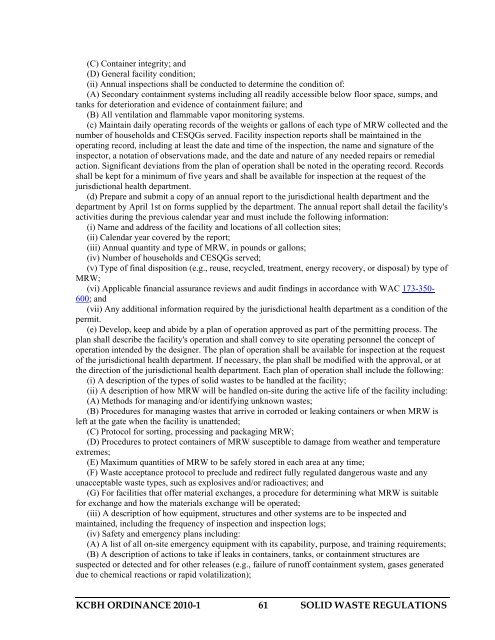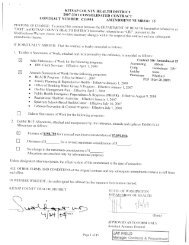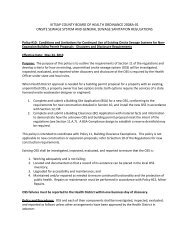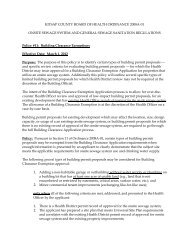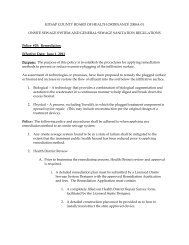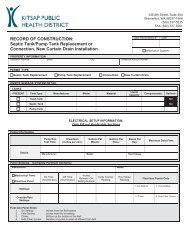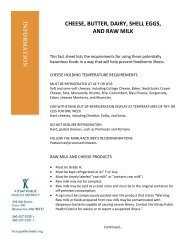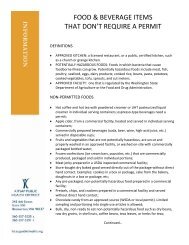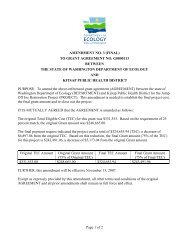SOLID WASTE REGULATIONS - Kitsap Public Health District
SOLID WASTE REGULATIONS - Kitsap Public Health District
SOLID WASTE REGULATIONS - Kitsap Public Health District
Create successful ePaper yourself
Turn your PDF publications into a flip-book with our unique Google optimized e-Paper software.
(C) Container integrity; and<br />
(D) General facility condition;<br />
(ii) Annual inspections shall be conducted to determine the condition of:<br />
(A) Secondary containment systems including all readily accessible below floor space, sumps, and<br />
tanks for deterioration and evidence of containment failure; and<br />
(B) All ventilation and flammable vapor monitoring systems.<br />
(c) Maintain daily operating records of the weights or gallons of each type of MRW collected and the<br />
number of households and CESQGs served. Facility inspection reports shall be maintained in the<br />
operating record, including at least the date and time of the inspection, the name and signature of the<br />
inspector, a notation of observations made, and the date and nature of any needed repairs or remedial<br />
action. Significant deviations from the plan of operation shall be noted in the operating record. Records<br />
shall be kept for a minimum of five years and shall be available for inspection at the request of the<br />
jurisdictional health department.<br />
(d) Prepare and submit a copy of an annual report to the jurisdictional health department and the<br />
department by April 1st on forms supplied by the department. The annual report shall detail the facility's<br />
activities during the previous calendar year and must include the following information:<br />
(i) Name and address of the facility and locations of all collection sites;<br />
(ii) Calendar year covered by the report;<br />
(iii) Annual quantity and type of MRW, in pounds or gallons;<br />
(iv) Number of households and CESQGs served;<br />
(v) Type of final disposition (e.g., reuse, recycled, treatment, energy recovery, or disposal) by type of<br />
MRW;<br />
(vi) Applicable financial assurance reviews and audit findings in accordance with WAC 173-350-<br />
600; and<br />
(vii) Any additional information required by the jurisdictional health department as a condition of the<br />
permit.<br />
(e) Develop, keep and abide by a plan of operation approved as part of the permitting process. The<br />
plan shall describe the facility's operation and shall convey to site operating personnel the concept of<br />
operation intended by the designer. The plan of operation shall be available for inspection at the request<br />
of the jurisdictional health department. If necessary, the plan shall be modified with the approval, or at<br />
the direction of the jurisdictional health department. Each plan of operation shall include the following:<br />
(i) A description of the types of solid wastes to be handled at the facility;<br />
(ii) A description of how MRW will be handled on-site during the active life of the facility including:<br />
(A) Methods for managing and/or identifying unknown wastes;<br />
(B) Procedures for managing wastes that arrive in corroded or leaking containers or when MRW is<br />
left at the gate when the facility is unattended;<br />
(C) Protocol for sorting, processing and packaging MRW;<br />
(D) Procedures to protect containers of MRW susceptible to damage from weather and temperature<br />
extremes;<br />
(E) Maximum quantities of MRW to be safely stored in each area at any time;<br />
(F) Waste acceptance protocol to preclude and redirect fully regulated dangerous waste and any<br />
unacceptable waste types, such as explosives and/or radioactives; and<br />
(G) For facilities that offer material exchanges, a procedure for determining what MRW is suitable<br />
for exchange and how the materials exchange will be operated;<br />
(iii) A description of how equipment, structures and other systems are to be inspected and<br />
maintained, including the frequency of inspection and inspection logs;<br />
(iv) Safety and emergency plans including:<br />
(A) A list of all on-site emergency equipment with its capability, purpose, and training requirements;<br />
(B) A description of actions to take if leaks in containers, tanks, or containment structures are<br />
suspected or detected and for other releases (e.g., failure of runoff containment system, gases generated<br />
due to chemical reactions or rapid volatilization);<br />
KCBH ORDINANCE 2010-1 61 <strong>SOLID</strong> <strong>WASTE</strong> <strong>REGULATIONS</strong>


